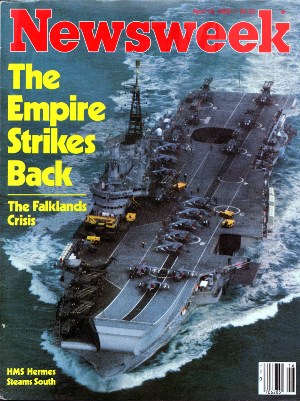Task Force South
The fleet of ships that sailed from Britain at the start of the Falklands conflict was known as Task Force South. It comprised naval ships and requisitioned merchant ships such as the well-known QE2.
As part of efforts to reclaim the Falkland Islands, a fleet of naval ships and requisitioned merchant ships such as the QE2 liner, sailed from Britain in 1982. This fleet was known as Task Force South and included more than 100 ferries, destroyers, aircraft carriers and support vessels.
Following the arrival of Argentine fleets near Port Stanley on 2 April 1982, an invasion of the islands and of South Georgia was begun. In Britain, Prime Minister Margaret Thatcher summoned military leaders to request that a task force been put in place immediately. First Sea Lord, Sir Henry Leach, was charged with overseeing this job and set to work, with the result being that, just three days after the invasion of the islands, two aircraft carriers sailed south from Portsmouth. These ships, HMS Invincible and HMS Hermes, were accompanied by Fearless, the assault vessel. They were charged with sailing ahead of the pack of naval ships being readied for conflict, in order to protect and enforce the 200-mile exclusion zone. The following day, 9 April 1982, another ship, a former liner called the Canberra, departed Southampton’s docks. Aboard was a number of military units including 3 Para, 40,42 and 45 Royal Marine Commando. Another unit, 2 Para, followed from Hull’s docks aboard the Norland at the end of April, while the former luxury liner, the QE2, sailed with Guards and Ghurkhas on board on 12 May.

The men on board the ships practiced their firing skills at Ascension Islands, on the way to the conflict. Sea skills were also honed by both the Royal Marines and the Parachute Regiment in case an amphibious landing would be required, which General John Moore had hinted at.
The journey to the Falkland Islands was perilous, with storms making the passage extremely rough. However, this was deemed a positive thing by the British troops as it meant that the chance of attack by the Argentine forces, either by sea or air, was lessened. However, HMS Sheffield was attacked and gave the British troops new impetus to begin the conflict.
Once the Task Force arrived in San Carlos Bay, many were damaged by bombs dropped by the Argentines. Some of the lost ships included the Coventry and the Ardent. The bigger ships remained away from the bay, as the Task Force was reluctant to risk losing those. The most well-known ship to be destroyed in the Falklands conflict was called the Atlantic Conveyor, which sank after being hit by an Exocet missile. This meant that the Chinook helicopters on board could no longer be used and the Sea Kings were forced to take over the job of transporting heavy weapons and equipment.
See also: San Carlos Waters
MLA Citation/Reference
"Task Force South". HistoryLearning.com. 2025. Web.
